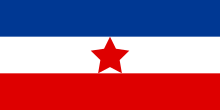| Revision as of 19:59, 8 March 2022 editPassando (talk | contribs)337 edits →Composition← Previous edit | Revision as of 00:00, 9 March 2022 edit undoDanCherek (talk | contribs)Autopatrolled, Administrators74,567 edits →Composition: remove quotation from a source that is readily accessibleNext edit → | ||
| Line 48: | Line 48: | ||
| *] was formed by republicans and anarchists during 1944. | *] was formed by republicans and anarchists during 1944. | ||
| *] was formed by liberals and monarchists during 1944. | *] was formed by liberals and monarchists during 1944. | ||
| Brigade Italia, later renamed Division Italia, was led by ] Giuseppe Maras; later the full division was formed by twelve battalions. Only a small part of the fighters were ] or ], while the majority fought for a ] Yugoslavia. |
Brigade Italia, later renamed Division Italia, was led by ] Giuseppe Maras; later the full division was formed by twelve battalions. Only a small part of the fighters were ] or ], while the majority fought for a ] Yugoslavia.<ref>{{Cite web|url=http://www.anpi.it/militari/belgrado.htm|title=La Resistenza dei militari italiani a Belgrado|date=August 5, 2007|archive-url=https://web.archive.org/web/20070805110334/http://www.anpi.it/militari/belgrado.htm|archive-date=2007-08-05}}</ref>The Italian combatants did not know the carnage of ] against Italian civilian people: the massacres were ordered by ], Yugoslav supreme commander.<ref>. Slovenian Presidency of the Council of the European Union. Retrieved 26 December 2019. p. 156.</ref><ref> | ||
| </ref> | </ref> | ||
Revision as of 00:00, 9 March 2022
| Divisione Italia | |
|---|---|
 Flag of the Yugoslav Partisans Flag of the Yugoslav Partisans | |
| Active | (Garibaldi battalion) 11 September 1943–7 July 1945 |
| Disbanded | 1945 |
| Country | |
| Branch | National Liberation Army (Yugoslavia) |
| Type | infantry |
| Role | Field army |
| Size | 5,000 about |
| Engagements | Syrmian Front |
| Decorations | Gold Medal of Military Valour to commander |
| Commanders | |
| Notable commanders | Giuseppe Maras |
Division Italia or Divisione Italia was a branch of the National Liberation Army of Yugoslavia during the Second World War. This division was formed by Italian soldiers.
History
After the Armistice of Cassibile, which was signed on 3 September 1943, the division was organized by Italian soldiers from the disbanded Second Army of Italy and Italians were recruited into the National Liberation Army. The Italian armed force Brigade Italia was formed in Belgrade on 28–29 October 1944 among the 1st Division (Yugoslav Partisans) under command of Koča Popović; its core was made up of two battalions: Garibaldi battalion formed on 11 September 1943 in Split, Croatia and Matteotti battalion formed in October 1943 in Livno. Other Italians, freed from German concentration camps, joined the brigade forming the third Mameli battalion and before leaving Belgrade for the Syrmian Front 2,283 soldiers had joined. The fourth Bandiera brothers battalion was later added.
Composition
Division was formed initially by four battalions with soldiers of varied political ideologies:
- Giuseppe Garibaldi was formed by communists on 11 September 1943.
- Giacomo Matteotti was formed by socialists in October 1943.
- Goffredo Mameli was formed by republicans and anarchists during 1944.
- Bandiera brothers was formed by liberals and monarchists during 1944.
Brigade Italia, later renamed Division Italia, was led by sub-lieutenant Giuseppe Maras; later the full division was formed by twelve battalions. Only a small part of the fighters were totalitarian or communists, while the majority fought for a democratic Yugoslavia.The Italian combatants did not know the carnage of foibe massacres against Italian civilian people: the massacres were ordered by Josip Broz Tito, Yugoslav supreme commander.
War operation
During the summer of 1943, Garibaldi battalion defended Split against Germans and their Yugoslav allies. Three times Garibaldi and Matteotti, risked annihilation from long range and long lasting German offensives. They earned the praise of Broz Tito and frequent citations in the bulletins of Radio Londra. After the breakthrough on the Syrmian Front, Brigade Italia pursued the enemy towards Zagreb and participated in the conquest of Belgrade. Italian fighters raised the flag of democratic Italy at the Italian embassy in Belgrade. Political commissioner Innocente Cozzolino temporarily served as Italian consul. Broz Tito wanted the Italian battalions in first row of the parade in front of him to the liberator departments. On 8 May 1945 Italian fighting units entered Zagreb after other hard fighting sustained in Tovarnik, Pleternica, and Slijem mountain. In June 1945 the brigade became a division with about 5,000 fighters in twelve battalions.
Dissolution
Division Italia returned to Italy on 2 July 1945 and on 7 July 1945 the unit was dissolved. Commander Maras was awarded with Gold Medal of Military Valour by the President of Italian Republic in 1968.
References
- Giacomo Scotti Ventimila caduti. Italiani in Iugoslavia 1943–45, printed by Mursia in Milan, 1970: in page 492 there is text regarding division Italia
- "La Resistenza dei militari italiani a Belgrado". August 5, 2007. Archived from the original on 2007-08-05.
- "Crimes Committed by Totalitarian Regimes". Slovenian Presidency of the Council of the European Union. Retrieved 26 December 2019. p. 156.
- <<"Lui” era Josif Broz Tito, per gran parte di noi il “nemico” assoluto, il responsabile dell’esilio dei nostri padri, l’infoibatore, il dittatore comunista">>
- "article by Giacomo Scotti" (PDF).
- "Le onorificenze della Repubblica Italiana". www.quirinale.it.